Text
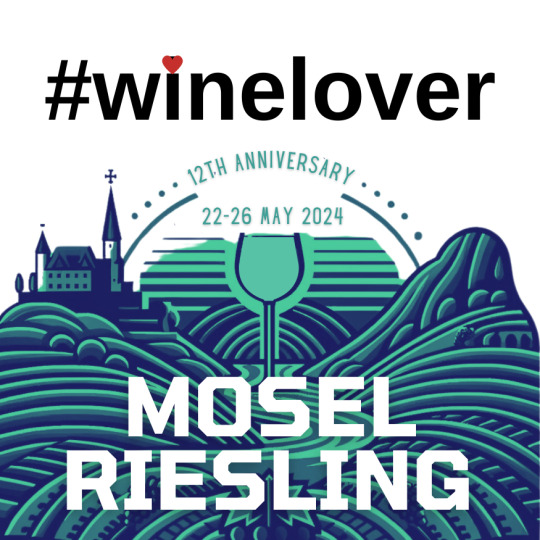
It's that time again! Time to fly off to meet my #winelover friends somewhere in the world. This time we are heading into the #summerofriesling with a bang! I adore Riesling and couldn't ask for better guides for my immersion than resident expert Jan Mattias Klein and Karin Luize De Carvalho.
They've planned visits to 2-3 star wineries in Rheinhessen/Bergstrasse, traipses through wineries in Mosel & Nahe, lodging at@staffelhof862
Walking to Vitiforesty Project for a tasting in the vineyard.
They have planned a tasting PIWI wines with new Mosel initiave "Vision Mosel" (www.vision-mosel.com); Tasting of aged Riesling wines @ @Weingut MartinMüllen. topping off the trip with
"Mythos Mosel, a Riesling Tour" (https://www.mythos-mosel.de/en/information-faq/) - Mythos Mosel is a unique vintage tasting grand event including around 120 wineries.
Stay tuned for the highlights of the trip #moselriesling24 is going to be a blast.
0 notes
Text

PINKIE RAISED OR NOT, THERE IS A REASON TO SWIRL THE WINE IN YOUR GLASS.
June 2024 By Carol López-Bethel, Wine Consultant & Educator at Swirl Wine Consulting
Many facets to learning about wine are science-based; others are cultural or tied to a perceived etiquette. Swirling the glass is one of the activities most often associated with snobbery, along with getting your nose all the way in the glass and spitting (but that’s for another story). People often ask me why I swirl and sniff when my glass is first filled and then again and again as I drink. Here’s why.
I chose the name Swirl for my consultancy because it embodies the scientific and practical aspects of increasing the aromatic and taste factors of the wine being consumed. All with a simple flip of the wrist, pinkie finger up or not! The reality is that a lot can be learned about what is in the glass by swirling.
First, visually, swirling uncovers the wine’s “legs” or lack thereof. Legs on a wine simply indicate a higher alcohol than glycerine content and may only indicate what the “mouthfeel” or “viscosity” will feel like on the palate. Lower alcohol dry wines will have fewer or non-existent legs while fortified wines like Port will drip like crazy. They are not an indication of quality, despite that guy who always shouts out “Look at the legs on this one!”
The purpose of aerating or allowing a wine to breathe is to open it up. Many older wines or young, highly tannic wines benefit from some time to breathe out of bottle and in some cases that can be accomplished with decanting. Decanting is a much-debated practice, has many fans, but is not necessary or appropriate for many wines. Beautiful and stylish decanters are favored displays for many wine collectors. Although I have a wide selection of decanters, I rarely use them, as my practice is to taste continually from the time the cork is pulled until the dregs of my last glass is finished. Everything I want to learn about the wine, I can discern by pouring from a heightened position (a free aerator, no wine toys required) and by swirling.
Swirling is always recommended, whether or not a wine has been decanted. Aficionados learn that swirling mixes in oxygen that unleashes aromatics and enhances flavor in the wine. The field of Physics backs up this premise—technically called "orbital shaking"—which creates a rotating gravity wave in the direction of the swirling force being applied, churning up the liquid in the process. In layman’s terms-it acts like a “scratch and sniff” patch, releasing the aromatic compounds and esters that have tightened from sitting in the bottle.
Another factor is the size of the glass. Those large-bowled glasses were not designed to be filled with wine; but with open space for the wine to release its aromatic characteristics and leave room for swirling. The amount of wine in the glass and whether you swirl it in wide or tight circles can create different levels of that release. The rim of the glass helps to contain those aromas. This is very helpful in a restaurant full of food smells and other people’s colognes. Pro tasters will judge a wine by how close to the rim or into the glass your nose must get for the wine to tell its story. For this reason, Grandma’s old crystal goblets may not be the best way to fully experience a quality wine.
It makes sense to swirl your wine in order to assess it fairly. Except with sparkling wines, as it reduces the bubbles faster than would otherwise occur. In addition to how to taste, I teach people to smell a wine first unswirled, then swirl and smell again to note the differences-then do it again, with tasting. The differences may surprise you. Does a swirled wine taste better than one tasted as poured straight from the bottle? That will depend on the quality of the wine in question, your palate and how much time you are willing to spend with it before determining whether or not you like it. I swirl and sniff continually as the wine evolves more quickly in an open glass than in an open bottle; so each refill speaks to me about the wine’s longevity. My benchmark for a good wine is one that maintains all its best qualities from the first to the last sip from the glass.
So, swirling your glass is not pretentious if you care to enjoy all that the bottle you invested in has to offer. If others choose to call you a wine snob, let the corks fall where they may!
0 notes
Text
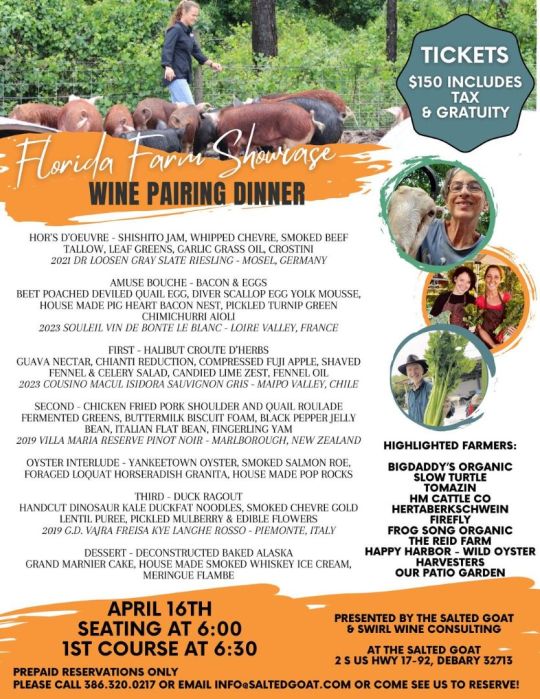
I'm excited to participate in my last Florida wine dinner of 2024. Kathryn Aymar and Chef Stopher Condry are two of the most dedicated and creative minds in the local food industry and Volusia County and surrounding areas are blessed to have them. I am thankful for the challenges that their unique offerings bring to the art of wine pairing and for their willingness to take this journey with me. This is going to be an explosively tasty menu which I am pairing with some of my favorite selections of the year so far. This dinner is not to be missed! If you can't make it, share this with someone you like or love, quickly, as seats are moving quickly!

0 notes
Text

What am I supposed to smell in this wine?
Your eyes are shut tight and your nose is dipped genteelly into your glass, seconds later your head lifts and you ask “What am I supposed to be smelling here?” “What do you smell?”. Alas, what I smell and what you and your table mate(s) smell are rarely the same, and guess what? It doesn’t matter.
Your wine came with a list of tasting notes including words like: Bing and dried cherries, tropical fruits, cedar, black raspberries and melon, even wet stone, leather, pencil lead and barnyard. You spend precious time that could be spent enjoying your purchase trying to find the experience the reviewer told you to expect. Are you confused, disappointed that you couldn’t discern what you were supposed to? Let it go and let’s move on to all you really need to know to “sacar todo el jugo” as the saying goes in Spanish- “get all of the juice out” of the experience.
Like most passionate students of wine (especially those seeking certifications and advanced degrees), I spend a great deal of time sniffing through spice cabinets, ethnic grocery stores and farmers market stands, blooming flowers and fruit trees, freshly mown grass and hay, the ocean breeze, the wet pavement after summer rain (petrichor), the earthy smell of an open field after a heavy downpour (geosmin). I smell the differences between Oolong, Earl Grey and Lapsang Souchong teas; between Italian espresso roast and Cuban coffee; between uncured and smoked bacon. In other words, I stick my nose into a lot of places where it doesn’t necessarily belong-also looking for signs of faults in a wine like: locker room, dirty laundry, geranium, rotten egg, burnt rubber, cooked garlic, or skunk. I volunteer at a local farm to smell freshly-dug earth and the growth stages in the lifespan of heirloom tomatoes. I grow seasonal veggies and herbs on my patio so that I can enjoy the scent of my Meyer lemon tree in bloom and the lingering smell of tarragon on my fingers at harvest. Many wine lovers are also great cooks who recognize the variations in aroma of a ripe vs an unripe ingredient, uncut vs sliced, raw vs cooked or a fresh vs fermented one. I recommend that anyone looking to more fully understand the vocabulary of wine begin by learning to smell, as many of the aromatic characteristics also reveal themselves on the palate.
For example, some well-ripened cheeses smell pungently of dirty socks. Not very appetizing to those who don't enjoy Époisses from France or Dutch Limburger but make sense to those who love them. The nuance of animal fat is especially prevalent in Syrah from France's Rhône Valley. A stone-like scent and flavor (some of us diehards have even licked the stones) are the hallmarks of Sauvignon Blanc from the Loire Valley, Champagne and Chablis. Many southern French reds hint at licorice. German Riesling often smells faintly of gasoline – in a good way.
The Wine Aroma Wheel is a helpful tool for learning to describe the complexity of wines by categorizing their characteristic aromas in relation to fruits, vegetables, flowers, minerals, animals, wood, oak and yeast, etc. However, none of this is very useful to someone unfamiliar with the aromas listed. Sadly, today’s supermarkets offer little help in identifying the scents on the wheel as most fruits and vegetables, especially imported tropical fruits (mango, papaya, guava, starfruit) were picked before prime ripeness and lack smell as well as flavor. I once told someone who didn’t like papaya that they most likely hadn’t had a local, fully ripened one. How many of us have access to fresh gooseberries, green almonds, persimmons or quince whether unripe or ripened? What about boysenberries and dragonfruit? Was that lychee fresh or canned? How many have plucked a fig or olive from the tree, can differentiate between the scent of iris, jasmine or lilac? Ever ride a horse or wear Granddad’s old leather bomber jacket? Do you smell your shitake, oyster and maitake mushrooms? See what I mean? This is not a game for everyone.
Having a common language for winetasting allows people of diverse backgrounds to communicate fluidly. Learning the basics is desirable and can add fun when sharing wine with others; but should not be stressful for the average consumer. At a recent tasting of wines from Bourgogne and Bordeaux, a heavily Aussie accented presenter swirled the glass before handing a juicy red Burgundy to me. He raised his glass to his nose as I did mine and we both said, almost in unison “Horsehair!”. The scent took us both back to the memories of saddling up a freshly brushed horse, while also hinting at the wine’s age and vineyard location. A connection was made. A Jamaican-American wine and food writer I know often refers to Barbados cherries, Marionberries, Hibiscus or Sorrel flowers and sea urchin. Do these hold any meaning for you? If so, enjoy these bonus associations when they occur, if not move on.
Detecting aromas is not a parlor trick or for showing off. Your server at a restaurant should be able to detect most faults in the wine before pouring. Let them examine the cork and discreetly sniff for off odors. If an off-putting aroma or bad taste slips by them, let them know, trust your judgement that the wine shouldn’t smell like a wet dog or taste like your kitchen sponge. A faulty wine is generally identifiable, so if this occurs with a bottle you open at home, cork it up and return it to the vendor, if possible. For this reason, I never tell attendees in my classes what to smell or taste; rather to “feel the sensations” of the wine. The important elements of a balanced wine are in its acidity, tannin structure, residual sugar level, alcohol by volume (ABV%), mouthfeel – assets that most people can detect - tartness, sweetness or the lack of it, the heat of alcohol and the thin or thick texture on the palate. After all, what the average drinker wants from a glass of wine is enjoyment.
If you fancy yourself “not average” by all means join me in exploring all the good and bad smells associated with wine – otherwise, as my class descriptions advise “Smell, Sip, Taste, Enjoy” and leave it at that.
0 notes
Text
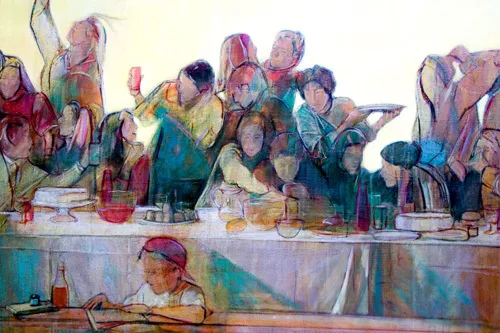
The Last Supper by Phillip Smeeton
Spring Forward to Wines for Easter and Passover
It is no wonder that Easter and Passover often occur so close together, even overlap in some years during the seven days Passover is observed in Israel and the eight days elsewhere among the Jewish diaspora. After all, the Last Supper was, in fact, a Seder. Redemption and salvation are the central themes of the Judeo-Christian ties between these highest of holy days. I was blessed to experience the breadth of these themes growing up in a blended family of Catholics and Sephardic Jews, hearing the stories and eating the food. The relationship is reflected not just on the calendar; but in the meals partaken by observers at either or both tables. So much is shared in common, except of course, pork, leavened bread, shellfish and mixing dairy and meat; but that’s a different story. Wine was at the center of each meal, especially for early Christians for whom it was safer than the local water to drink.
Let’s design a list of wine pairings to bridge the gap-satisfy most palates without bending too many “kashrut” rules. For Passover you need Kosher wines, wines made by Sabbath-observant Jews with no non-kosher additives used in the process. Kosher status is typically denoted by the letter U or K in a circle, with a P in superscript. “Mevushal” wines are flash-pasteurized so they can be handled by non-observant folks yet remain kosher. At Seder each adult will sip from four cups of wine, representing the redemption of the Israelites from Egyptian slavery. A fifth cup is left unconsumed and reserved for the prophet Elijah. I like to propose five or six wines, to keep things interesting. Those celebrating the Resurrection of Christ can pair one wine with each course; serve one white and one red or stick with Welch’s-no judgement here.
So feel free to pass on the Manischewitz, my suggestions, like champagne, go with everything and will pair well with carrot tzimmes for Passover as well as that ubiquitous spiral cut ham on Easter. For starters- Champagne Drappier-The Drappier family tree can be traced back to1604. Since 2016, the eighth generation of the Drappier family incorporates animals and nature preservation, ploughing parts of the organically-farmed vineyard by horse and earning “Carbon Neutral” accreditation. Drappier estate creates a wide array of Pinot Noir based demi-sec to extra brut cuvees, including “sans soufre” or zero dosage (added sugar), zero sulphur added bottlings, all delicious.
For the meal-Psagot Rosé is a blend of red varietals harvested from vineyards in the Northern Jerusalem Mountains. It is a beautiful salmon colored, dry wine with aromas of pink grapefruit and lemon zest. Psagot Edom is a well-rounded proprietary Bordeaux blend of Cabernet Sauvignon, Merlot, Cabernet Franc, and Petit Verdot. Balanced and harmonious, it has a rich and wide structure with layered flavors and aromas. Ditch the mint jelly and pair this with a garlicky roasted leg of lamb or braised lamb shanks for Seder or Easter dinner. Check Total Wine for the wines listed above, quickly as they sell out fast this time of year.
Not all kosher wines are made in Israel and not all wines made in Israel are kosher. Ask your local merchant for recommendations. Other kosher producers that I like include Tulip, Flam and Teperberg…wineries that make wonderful wines from Israel to round out your kosher friendly list. For further biblical references, I turn to Palestine and Armenia for non-kosher but relevant selections. Cremisan Wine Estate sits on the West Bank of Palestine overlooking Bethlehem, in a monastery established in 1885 by Italian Monks making an array of wines using organically grown, auctochthonous, Palestinean grapes. Star of Bethlehem Dabouki is a super crisp white wine which smashed my misconceptions of winemaking in what I presumed was a day and night hot desert. This delightful wine has all the hallmarks of a moderate to cool climate - clean, stone fruit, tropical fruit notes and beautifully balanced minerality and acidity. Cremisan was the first winery to produce wines from local Palestinian grapes and to test their genetic analysis to confirm which are native to Palestine. The main varietals grown there are Dabouki, Hamdani, Jandali, Baladi, along with Cabernet Sauvignon, Viognier, Petit Verdot and Merlot. They created a unique distillery made of copper, from which Cremisan has produced a brandy now aged for 35 years in oak barrels. In 2020 Cremisan also started to make a unique traditional Arak from 53% Dabouki grapes.
The bible tells us that Noah’s Ark rested upon Mount Ararat, part of which lies in present day Armenia, where Noah planted grapes to celebrate the survival of humanity (my guess is that the animals were also grateful). Rich in historical and biblical references, Armenia is reviving its claim as one of the oldest wine growing regions in the world (Georgia and China argue otherwise; but again, that’s another story). Armenia was also home to one of the worst cases of genocide in the 20th century (please look it up, we should know these things).
My first encounter with Armenian wines took place in Montreux, Switzerland where I met winemaker Zorik of Zorah winery, who returned to Armenia after years in Italy to uncover the history and secrets of more than 6,000 years of winemaking that had been all but wiped out during Soviet rule. Zorik salvaged old vineyards, researched and collected amphora to recreate that rich history which now represents the pinnacle of his now highly prized and allocated wines.
American, Paul Hobbs journeyed from fame as a Napa Valley golden child in the ‘90’s to Argentina, then Cahors, France then further east to create Yacoubian-Hobbs, a collaboration with the Yacoubian brothers in 2008. Reviving such ancient varietals as: Voskehat -or "golden berry" the emblematic white variety of Armenia; Khatuni; Qrdi and Garan Demakor "sheep's tail". I adore the white blend and the red Yacoubian-Hobbs Sarpina of 100% Areni from the southern highlands. I felt like I’d encountered the burning bush in the desert that told me that I had found home. The flavors are like a Burgundian style Pinot blended with St. Joseph Syrah, satiny dark fruit aromas with muddled strawberries, blackberries, pomegranate, black cherries, black pepper, anise and bourbony vanilla.
There is so much to unpack here in the delta where Christianity and Judaism cross paths. So much history and so much yet to be discovered. What better place to start this discovery than at the table? Happy Easter and Chag Pesach Sameach!
0 notes
Text
Opinions are like A$$h@les, everybody has one, right? "What is better?", "what is best?". I am often asked "what is the best wine?", "which is better?".
One of the most important things about wine, in my view, is that taste is subjective-quality is objective. Taste or preference can be guided by one's palate, by the desire to be seen as knowledgeable or sophisticated, by aligning one's taste with a renowned "expert" or reviewer, even just wanting others to know that you have enough disposable income to afford expensive wines- I've seen them all. Objectively, quality in wine can be stated matter of factly with knowledge of its provenance-its country of origin, vineyard location, growing practices, cellar practices, environmental impact, winemaker reputation and history, importer reputation etc. Conversely, the highest quality standards in winemaking don't automatically win a wine everyone's preferred taste.
As Lettie Teague points out, red wine gets more press than white wine, though they each get their share of hate mail- "I hate Merlot." "ABC-Anything but Chardonnay". Counting Champagne in the white wine category (which many consumers don't know to do) may close the gap a bit. Set aside the stereotypes of white (feminine), red (masculine) and the perception of greater health benefits attributed to the polyphenols in reds, the misguided belief that reds contain more sulfites, etc. and the stats may change yet again. Many consumers define their taste preferences depending on the source of their information or misinformation.
My basis for selection of both white and red wines are almost all focused on quality-all aspects of quality. Hence, to rate one classification over another when all quality factors aren't on a level field is impossible. A commercially produced, highly manipulated 100 point Cabernet Sauvignon is in most cases inferior to a biodynamically produced Chardonnay from a small, unknown producer -in my view-you will see some examples in my posts. As to the intellectual and complexity assertions that reds offer more-I refer my readers to select a well aged Reisling, dry Furmint or white Rioja, an Orange wine Rqatsiteli from Georgia among others. I have labeled many high quality complex whites "meditation wines" while calling many simple reds "agua fregada" or dishwater.
My answer is to never speak in absolutes. Just like 1+1 doesn't always equal 2- like when two clouds or a couple come together as one. Every question deserves a nuanced answer and this one is very close to my heart, so I had to reply
#winetasting#winelover#womenofwine#womeninwine f#emalewinemakers#femalesommeliers#sommlife#wineeducation
0 notes
Text
Garnacha-Grenache The Vines that bind Spain and France
0 notes
Photo

Forks & Corks Food and Wine Competition-Sarasota, FL
Nothing makes me happier than thrusting my nose into a glass of wine and judging its contents. I do it on my own, but particularly enjoy being on a panel. So thank you Forks and Corks Wine Competition of Sarasota for having me back as a judge. We'll soon see what the list of 80 well known wineries from around the globe brings to the table and which will be chosen as best in class.
0 notes
Link
Women hold up half the sky and when we put our heads together we are capable of so much more than what we can do on our own. Rising water raises all boats and if one woman succeeds and brings others up with her the whole world benefits. Kathryn Aymar gave me the opportunity to add female farmers to my ongoing program of supporting women in the wine industry-growers, winemakers, sommeliers, etc. Collaborating with her to bring together this dinner allowed me to bring my passion for local food and great wine into a closed circle. Thanks to all who attended and who continue to support the local farmers to which the dinner was dedicated.
0 notes
Photo
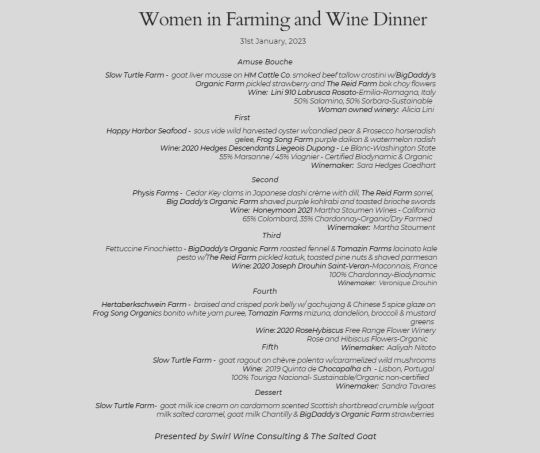
Thanks to everyone who put their faith in #physisfarms and me to bring you a true #farmtotable experience. The devil is in the details, every ingredient must be picked at its prime and perfection. So this menu includes those final details like the handpicked wonderful bok choy flowers and unexpected beautiful greens from #tomazinfarms that we're not included in previous posts.
Sharing impeccably sourced and prepared food and wine with you is one of my greatest pleasures and I am grateful for all who come tonight for allowing this opportunity.
0 notes
Link
I was searching through some old folders while preparing to teach a champagne class later today and came across this old post from @shittywinememes.
This interview captured my overall philosophy on wine and life and answers many often asked questions about what I drink and why. It’s complicated and complex and a deeply satisfying way to indulge my passion and to share it.
https://www.instagram.com/p/COpzJeJt2vI/ link to the rest of the interview is @shittywinememes
0 notes
Link
0 notes
Photo
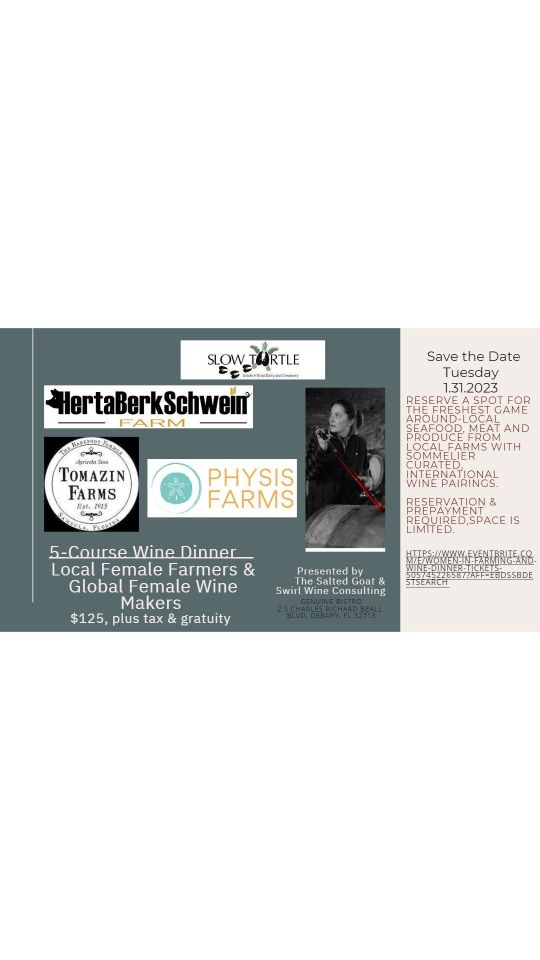
This will be the first and best, true #farmtotable dinner in the region. We are walking the talk with the real deal bringing the best from women who farm and make great wines.
Get your tickets while they last!
0 notes
Photo

For me wine is first and foremost about pleasure, and that includes the intellectual stimulation that comes from learning about so many of the lesser known regional and indigenous grapes around the wine growing world. Mondeuse is one of them. Grown in the Savoy region of eastern France and some parts of Argentina it is a grape known to very few outside of the wine professional community. A pocket wine among sommeliers not found on many menus or retail shelves.
I sought out this bottle because I’ve never tasted it on its own as a single cepage. It most commonly resembles Muscardin from the Southern Rhône, which is one of the 13 varieties permissible in Châteauneuf-du-Pape, but rarely bottled on its own.
2020 Romain Chamiot, Savoie Mondeuse exhibits all the characteristics of limestone scree and organic farming. On the nose a bit of smokiness, iron ore and crushed rock mixed with pomegranate, red currant and high elevation herbs. The attack is edgy with medium bodied acidity and much softer tannins than expected. This is just the right companion for braised beef with horseradish and potatoes scalloped with 5 year plus Gruyère or a sip to sit and savor-while contemplating how it differs from everything else in your cellar.
0 notes
Link
0 notes
Link
0 notes
Link
0 notes